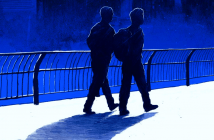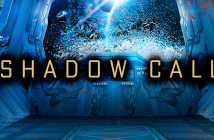Science Fiction has always been, to me, about hope. About what we could accomplish. About the consequences of our actions—good and bad. About how far we as a human race could reach if we left all the fear and hate behind and, with a united hand, stretched for the stars.
When I was a wee thing with boring brown hair and thick-lensed glasses, I devoured science fiction in as many forms as I could get my hands on. I inhaled cartoons like “X-Men” and “Teenaged Mutant Ninja Turtles.” I chewed through superhero comic books. I read books filled with far off worlds and unbelievable inventions. I listened to a recording of the infamous “War of the Worlds” broadcast. I read Ursula K. Le Guin, HG Wells, Frank Herbert, Octavia Butler, Margaret Atwood, Orson Scott Card, and many others good and bad. I watched “Star Wars” and “Star Trek” and “Sliders” and “Quantum Leap” and “Earth 2” and “Stargate SG-1” (plus its spinoffs) and “The Faculty” and “Aliens” and “Predator” and “Battlestar Galactica” and “Logan’s Run” and “Lost In Space.” I played “Blazing Lazers” and “Super Star Soldier,” beating them so many times I could play them in my sleep. Any time anything hit the market that could be labeled science fiction, my hands were on it one way or another.
It has always been the genre of possibility. Where anyone can be anything. Where people can be great and anyone can be a hero.
Despite what the Old Guard of science fiction would tell you.
For many years (and even still today) the self-assumed gatekeepers of science fiction will tell you that it’s only for men. That it’s only for white people. That it’s only for straight people. That it’s only for the privileged because the privileged will be the ones to pay the way to space. That it’s only for the abled. That it’s only for those who have no religion (or only believe in X religion).
The more science fiction evolves, the more the Old Guard hangs on by their fingernails and we end up with groups like S*d P*ppies.
In YA, Science Fiction has been a world that straddles the line between hope and consequence. Every year, the genre unfurls to be more inclusive of women and non-binary genders. To welcome those with disabilities and mental illnesses. To beckon those who worship and those who don’t. To bring all sexual and romantic orientations into its pages (some more than others). To carve race into its canon as something to be proud of no matter your origins and bloodline.
It’s exciting.
With the advent of #ownvoices (by YA author Corinne Duyvis) and #weneeddiversebooks (by the We Need Diverse Books organization), we’re seeing a boom in speculative fiction of people finally finally feeling like they can tell their stories.
Is it perfect? Far from it, but we move steadily forward (at a pace that could, in this author’s opinion, move faster). Each year boasts more and more books with lady and non-binary leads who aren’t all white, straight, and abled.
The science fiction canon grows larger, spreading across the cosmos like the billowing stars above our heads at night. Once again, I feel the same wonder that brown-haired child with coke-bottle glasses did. It doesn’t feel all the same as much as it did.
The hope is back. More for some than others, and I truly hope it continues to grow and spread to include everyone, regardless of race, orientation, identity, disability, religion, and station.
The wonderful thing about science fiction is that it allows us to imagine any future we want. For some, that’s away from this planet and colonizing whole new ones. For others, that’s advancements in technology to make all our lives better. For still others, that’s not making the same mistakes as our ancestors when we meet other species.
In writing, this means you can’t (and don’t have to) fall back on the excuse of time and place to justify your white, straight, largely male cast. It means you can have a colony entirely of women. It means you can have a genderfluid captain of a starship. It means you can have a Muslim lady defending her homeworld from an invading species. It means you can have a Black girl being bitten by the insect which then gives her badass superpowers. It means you can write a biracial bigender lead who is The Chosen One.
Some would look on this and scoff.
I look on it and practically vibrate with the joy of possibility.
With a genre as big as the cosmos itself, how could you not love the wealth at your fingertips? Nothing is unrealistic. There is no normal. There is no default.
There’s only you and the page.
And the stars.
Like this post? Read the rest of our Starship Ladies series.





2 Comments
LOVE THIS! I too grew up with the scifi of old and you’re right. It was always about hope and possibility. It needs to move forward into a new future, not one mired in 60s mentality.
Pingback: Exploration of the Genre: A Starship Ladies Recommendation Masterpost - YA Interrobang